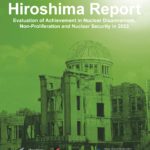(8) FMCT
A) Efforts toward commencing negotiations on an FMCT
In the “Decision 2: Principles and Objectives for Nuclear Non-Proliferation and Disarmament” adopted at the 1995 NPT Review and Extension Conference, participating countries agreed on the immediate commencement and early conclusion of negotiations on a Fissile Material Cut-off Treaty (FMCT) at the CD. However, substantive negotiations have not yet commenced. The 2021 session of the CD again ended without adopting a program of work that included the establishment of an Ad Hoc Committee on an FMCT negotiation, due to Pakistan’s strong objection, as had been the case in previous years. Pakistan has insisted that not just newly produced material but also existing stockpiles of such materials should be subject to the scope of negotiations on a treaty. China has expressed support for the commencement of negotiations on an FMCT prohibiting the future production of fissile material for nuclear weapons, but has done so less actively than the other NWS. Israel has a similar posture.
At the 2021 UNGA, a resolution, titled “Treaty banning the production of fissile material for nuclear weapons or other nuclear explosive devices,”204 which called for immediate commencement of FMCT negotiations at the CD, was adopted with 182 countries in favor, one against (Pakistan) and five abstentions (Egypt, Iran, Israel, North Korea and Syria).
B) Moratoria on production of fissile material for nuclear weapons
NNWS, in particular the Non- Proliferation and Disarmament Initiative (NPDI) member countries, have called on the nuclear-armed states to declare and implement a moratorium on the production of fissile materials for nuclear weapons until an FMCT is concluded.205
However, China, India, Israel, Pakistan and North Korea have not declared a moratorium on the production of fissile material for nuclear weapons. Among them, at least India, Pakistan and North Korea are seen as highly likely to continue producing fissile material for nuclear weapons.
North Korea was considered to have produced fissile materials and conducted related activities in 2021, as in the previous years. The IAEA in a report released in August 2021 said that: the state’s Radiochemical Laboratory likely operated for approximately five months, from mid-February 2021 until early July 2021; the five-month timeframe is consistent with the time required to reprocess a complete core of irradiated fuel from the 5MW(e) reactor; and since early July 2021, there have been indications consistent with the operation of the reactor.206
In addition, according to analyses by U.S. experts, commercial satellite imagery of North Korea’s Yongbyon Nuclear Scientific Research Center from January and February 2021 indicates that its Uranium Enrichment Plant (UEP) continued operations.207 In September, satellite images revealed expansion of a facility capable of producing weapons-grade enrichment uranium in Yongbyon. It was assessed that the renovation could increase highly-enriched uranium (HEU) production capacity by as much as 25%.208 In November, it was also reported that a graphite-moderated reactor, which has been used to produce plutonium for nuclear weapons, was in operation.209
It is considered that China does not currently produce fissile material for nuclear weapons. However, Beijing has been negative about declaring a moratorium on production. China’s ambassador to the CD maintained that, “A moratorium on production is not the fundamental path to completely and effectively resolving the FMCT issue.
Especially in this day and age, what some countries affirm today they may deny tomorrow, and a current administration can arbitrarily repudiate all the policies and commitments made by a previous one, leaving the international community at an even greater loss as to what course to take.”210 On the other hand, there are concerns that the advanced fast-breeder reactors and reprocessing facilities that China is developing as civilian purpose may be diverted for nuclear weapons purposes.211
As for Israel, satellite images analyzed by experts showed that a significant expansion is underway at the Dimona nuclear complex, which is believed to have been producing plutonium for nuclear weapons.212 While Israel has not disclosed the purpose of the expansion, another expert suggests that it may be building a facility to produce tritium for use in nuclear warheads.213
None of the nuclear-armed states have declared the amount of fissile material for nuclear weapons which they possess (except for the U.S. declassifying the amount of its past production of HEU and plutonium). Estimates by research institutes are summarized in Chapter 3 of this Report.
204 A/RES/76/51, December 6, 2021.
205 NPT/CONF.2020/PC.III/WP45, April 29, 2019. The NPDI was formed by Australia, Canada, Chile, Germany, Japan, Mexico, the Netherlands, Poland, Turkey, and the United Arab Emirates in September 2010.
206 GOV/2021/40-GC(65)/22, August 27, 2021. See also, for instance, Frank Pabian, Jenny Town and Jack Liu, “North Korea’s Yongbyon Nuclear Complex: More Evidence the 5 MWe Reactor Appears to Have Restarted,” 38 North, August 30, 2021, https://www.38north.org/2021/08/north-koreas-yongbyon-nuclear-complex-more-evidence-the-5-mwe-reactor-appears-to-have-restarted/.
207 Peter Makowsky, Frank Pabin and Jack Liu, “North Korea’s Yongbyon Nuclear Center: Working through Winter,” 38 North, February 19, 2021, https://www.38north.org/2021/02/north-koreas-yong byon-nuclear-center-working-through-winter/.
208 Zachary Cohen, “Satellite Images Reveal North Korea Expanding Facility Used to Produce Weapons-grade Uranium,” CNN, September 16, 2021, https://edition.cnn.com/2021/09/16/politics/north-korea-yongbyon-expansion-satellite-images/index.html; Jeffrey Lewis, “Yongbyon Enrichment Plant,” Arms Control Wonk, September 16, 2021, https://www.armscontrolwonk.com/archive/1213420/yongbyon-enrichment-plant/. Regarding the development of the uranium enrichment plant in Yongbyon (2009-2021), see also Olli Heinonen, “Development of the Yongbyon Uranium Enrichment Plant Between 2009 and 2021,” 38 North, July 16, 2021, https://www.38north.org/2021/07/development-of-the-yongbyon-uranium-enrichment-plant-between-2009-and-2021/.
209 Olli Heinonen, Peter Makowsky, Jack Liu and Jenny Town, “North Korea’s Yongbyon Nuclear Complex: Further Evidence of 5 MWe Reactor Operations,” 38 North, November 24, 2021, https://www. 38north.org/2021/11/north-koreas-yongbyon-nuclear-complex-further-evidence-of-5-mwe-reactor-ope rations/.
210 “No Clear Path forward for Fissile Material Cut-off Treaty,” IPFM Blog, May 24, 2020, http:// fissilematerials.org/blog/2020/05/no_clear_path_forward_for.html.
211 See, for instance, The U.S. Department of Defense, Military and Security Developments Involving the People’s Republic of China 2021, p. 90.
212 Sang-Min Kim, “New Work Underway at Israeli Nuclear Site,” Arms Control Today, April 2021, https:// www.armscontrol.org/act/2021-04/news/new-work-underway-israeli-nuclear-site.
213 Richard Silverstein, “What is Israel Building at its Dimona Nuclear Site?” Middle East Eye, March 5, 2021, https://www.middleeasteye.net/opinion/israel-nuclear-site-dimona-what-building.





